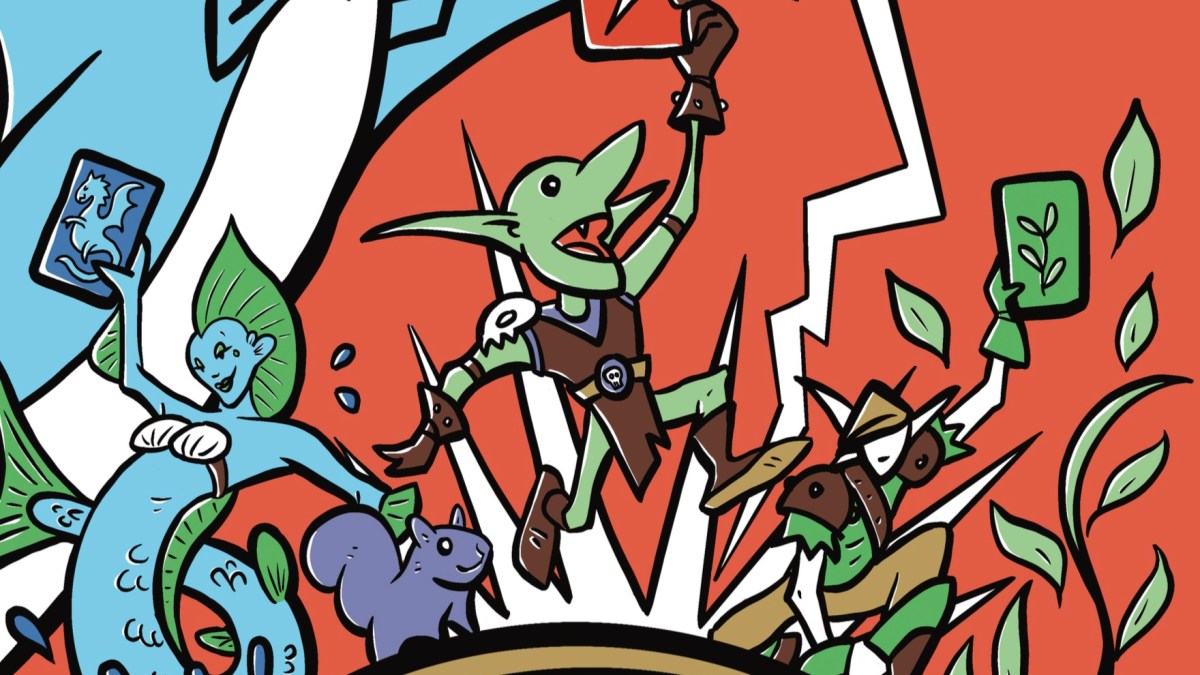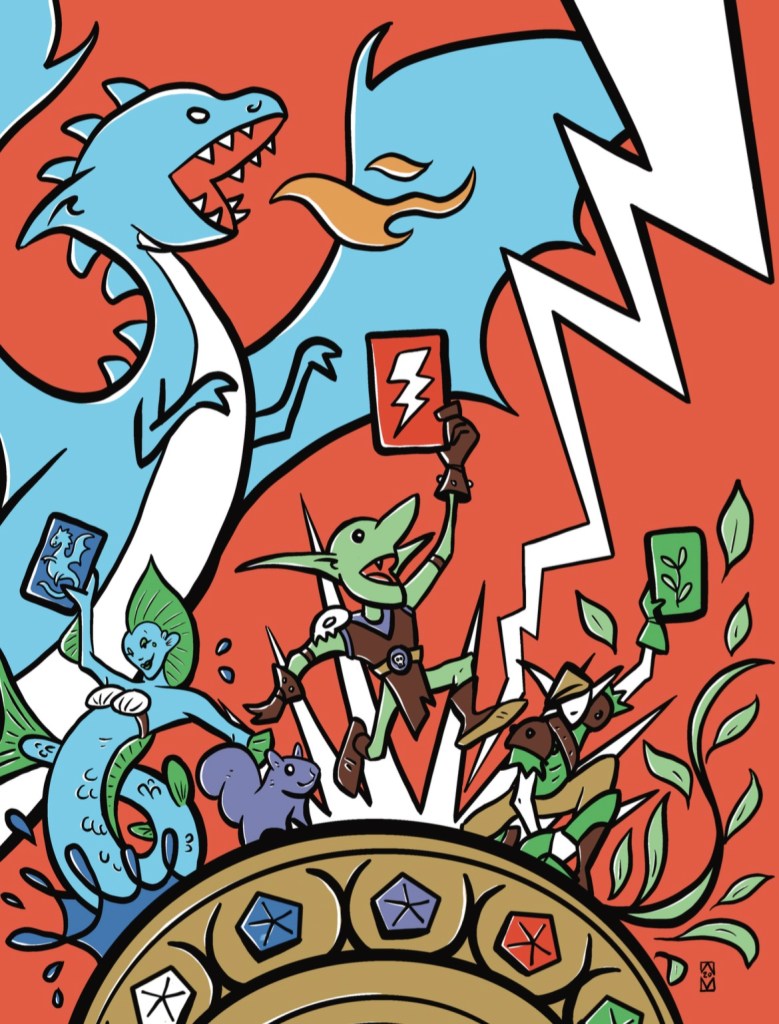Pokémon, Magic: The Gathering, and Secrets of the Pro Trading Card Games World
Whether it’s Magic: The Gathering or Pokémon, we got the inside scoop on what it takes to be a professional TCG gamer.

Presented by: 
This story appears in the Den of Geek x eBay special edition trading card magazine.
When it comes to versatile gaming, nothing quite compares to a good trading card game. Anywhere, any time, as long as you each have decks and somewhere flat to lay them down, you can play. Of the many available, Magic: The Gathering and Pokémon Trading Card Game are easily among the best for beginners. One of the pillars of table-top gaming, Magic is a multi-colored blowout of intrepid sorcery and ferocious monsters, all wrapped up in nearly three decades of fantasy lore. Pokémon needs no introduction, and just as the video games have gone from strength to strength since the days of Red and Blue, so too has the spinoff card game.
Giving either of these games a go has never been easier, between the wide circulation of the packs themselves, and the digital versions one can play for free. Indeed, Magic: The Gathering Arena and Pokémon Trading Card Game Online provide a fully digital replication of the intense tit-for-tat the TCGs are known for, allowing you to build and test combinations wherever you can find good WiFi. We caught up with Autumn Burchett, a Magic: The Gathering pro, and Azul Garcia Griego, a Pokémon TCG expert, to discuss their careers in card gaming, why they love these communities so much, and what decks and cards you should be looking for if you want to be among the elite.
Meet Autumn Burchett | Magic: The Gathering
Autumn Burchett is a professional Magic: The Gathering player who, in February 2019, became the inaugural Mythic Champion. Making their Pro Tour debut in 2015, Burchett had previously achieved first place in the UK Nationals in both 2017 and 2018 before making the jump to global gold. In that time, it wasn’t just the best of the best they were up against, but revolving systems, too, as Magic restructured its competitive layout from the Pro Tour to the Mythic Championship, from which it’s changed again to this year’s Players Tour. Finding and competing against the best players in the world is an enjoyable challenge, says Burchett, but the added spotlight wasn’t easy to get used to.
“I felt a lot of pressure at first as I really didn’t want to let down the fans I gained from that victory,” they tell us. “It’s taken a lot of time to adjust to that, and to refocus myself again.”
In a typical year, Burchett would travel a dozen or more times around the world to attend Magic: The Gathering events. Around a third of their life is spent on the road in fact, between the crucial tournaments needed to be in world championship contention and other invitationals. Naturally, playing against Magic‘s top-tier is always a thrill, but getting to see and meet the people who make up the local scenes is the real reward of being a touring player.
“I love competing at the highest level events with players from so many different places attending,” they say. “That said, my favorite part of events will always be spending time with friends, and going out for food after the games are done, whether catching up with local friends who I’ve known for many years or getting to see international friends again.”
Unfortunately, for much of 2020, flying internationally has been a no-go, with even local gatherings being improbable until towards the end of the year. Thankfully, online game Magic: The Gathering Arena means pro players can still practice and compete at a high level. Since its release in 2019, the free-to-play version of the TCG has made it much easier for anyone — veterans or those just curious — to get a deck and start playing. “It has definitely widened the audience,” Burchett says. “I know a few people who have been able to have success in part due to digital Magic just inherently being more accessible.”
Burchett has been using online tournaments to stay sharp, like the Star City Games Tour Online, an Arena-centric version of the Star City Games Open Series that normally occurs throughout the year. It’s expected that Arena will be a cornerstone of pro Magic from here on out, meaning digital competitions will still be integral even when players can roam freely again. Between those and Twitch, Burchett has been able to maintain some semblance of a routine, while still interacting with their fanbase and giving the Magic audience somewhere to hang out. It’s a learning experience on both sides, all coming together for a love of these five-colored spells.
“[Arena] encourages me to try out different decks that I might not otherwise,” Burchett says. “I’ve definitely had people say that they started playing again because they enjoy my content or seeing me succeed which is always flattering and makes me happy to hear.”
For anyone looking to make their first steps into Magic: The Gathering, Burchett recommends going Mono-Red Aggro, a recurring deck type that’s all about blowing your opponent up as swiftly as possible. “Your role in any given match-up is generally pretty clear: try to kill your opponent as fast as possible,” they explain. “It can also have a lot of depth to it too though, which makes it easy to learn and hard to master.”
Although playing against random opponents in Arena is good for developing skills, and streams and YouTube videos can provide a semblance of real-life communal play, nothing compares to sitting down with a friend and going a few rounds to see what’s what.
“Find someone else who plays the game and play with or against them,” Burchett says. “The game is a lot more fun when you’re sharing the experience with a friend, or battling against them, and it’s a lot easier to learn that way too.”
Autumn’s Deck
Burchett’s favorite deck at the moment is Temur Reclamation, a Blue, Green, and Red build centered on Uro, Titan of Nature’s Wrath, a 6/6 mythic rare from Theros Beyond Death. Uro’s a blue-green elder giant that gives you three life, lets you draw a card, and play a land card from your hand when it enters the battlefield or attacks. Getting it out involves exiling cards from your graveyard in addition to its mana cost, but once it’s in play, it’s tough for any opponent. At around $45 on eBay, Uro can be expensive, but it’s easily the largest investment in the deck.
Green and Blue land Breeding Pool is the next highest price-point, coming in at about $30 per card, with Blue and Red equivalent Steam Vent costing $12 or so.
Guilds of Ravnica rare Expansion/Explosion is one of the more costly instants, a Blue and Red split card that lets you either copy a spell and select new targets, or deal X damage to any target.
Brazen Borrower, a Throne of Eldraine mythic rare, is often an accompanying creature for Uro, a flash, flying 3/1 that has an instant power of returning a non-land permanent to an opponent’s hand that’ll run about $15.
Two other enchantments, Shark Typhoon, a Blue spell that makes shark tokens from the converted mana cost of noncreature spells you play, and Wilderness Reclamation, which untaps your lands during the end phase, come in just under $5 to round out the major buys.
“I love Temur Reclamation, it has a lot of flexible play patterns and game-plans,” Burchett says. “Figuring out what role to take in any given game or match-up is a lot of fun as a result.”

Meet Azul Garcia Griego | Pokémon
Azul Garcia Griego began playing the Pokémon Trading Card Game the way many kids did—by just making up the rules so the game was more like the popular anime and video games. But after being invited to a local Pokémon League to learn how to play properly and compete, Griego became obsessed with becoming the very best, like no one ever was. Now he’s a regular international competitor, as well as a streamer and coach, showing new players the ropes as the Pokémon TCG global scene continues to expand.
“When I first started playing, you could go to one regional per season, all the regionals happened on the same weekend, so we went to one weekend,” Griego says. “Now, I’m in America, but if I wanted to go to the ones in Europe and stuff, I could go to 20-plus regionals in a year.”
The last two years, Griego’s been doing laps of this circuit, leaving his home state of Massachusetts around two dozen times, traveling as far as Berlin, London, São Paulo, and Melbourne to compete. Obviously, the playing itself is a major attraction, getting to go against the best from every country and see their approach, but it’s the friendly atmosphere that makes being a career player worthwhile.
“At this point, there are so many people to say ‘hi’ to and just to catch up with, even if just to talk about the games that we’re having today at the regional or whatever it might be,” he says. “Then, doing other stuff like playing other kinds of board games and stuff that people bring to the event to just kill time in between rounds. We’re all just hanging out until the event’s over anyway, so it’s just always a great time.”
Mirroring the Pokémon games, the current sets in standard format for the trading card game are based on 2016’s Sun and Moon and 2019’s Sword and Shield, or generations seven and eight, respectively. So far, two expansions have been released for Sword and Shield, the base set, and Rebel Clash, with a third, Darkness Ablaze, set to drop this August.
Griego doesn’t worry too much about the balancing in standard, always willing to adapt to whatever the prevailing strategies and decks are, but he does think that right now, the playing field is in a decent spot. “It’s pretty good right now, there’s around five or six decks that are contenders to win any tournament,” he explains. “Last meta there was one deck that was by far the best, nothing else was close to its power level, so the meta got played out very quickly.”
Given that traveling and socializing is limited for 2020, Pokémon Trading Card Game Online has been the backbone of competitive Pokémon. He’s been taking part in tournaments there, where he’s encountered a number of players who only play digital, inspiring him to arrange his own for his Twitch and YouTube subscribers.
“I’ve had quite a few people, through just streaming or talking to them, who are only playing in these events because they only play Pokémon TCG Online,” he says. “They don’t play with real life cards, so it gives them a way to play into the game, which is really nice.”
That’s not to say Pokémon Trading Card Game Online isn’t a gateway, but going from playing in the comfort of home, to facing your opponent eye-to-eye, can be daunting. Some of Griego’s Pokémon students actually came to him for coaching so they could build their confidence in making the leap from online to real life. “When the new season comes around, they want to attend events and be a little more refined in their skills going into that.”
While the number of fans for Pokémon TCG related content is relatively small, it’s growing, and Griego reckons that if the online version got a contemporary overhaul, it could see a real boom in interest.
“Twitch would be a great place to grow, and I’m always hopeful that one day a new, clean, fresh client comes out because Pokémon Trading Card Game Online is really old,” he says. “I think it could definitely blow up to the point, you know, of something like Magic: The Gathering Arena or Hearthstone.”
Azul’s Deck
Griego’s deck of choice is the Combo Zacian, a build that surprised him with its versatility when he sat down to play with it. The main mechanic involves cycling through Prize cards on your bench. The namesake, Zacian V from the Sword and Shield collection demands a high price, since the deck is commonly taking players to the top eight, at $74 on eBay. For that money, though, you get a strong attacker – Zacian can do 230 damage for three metal energy – and during your turn you can draw three cards, attach any metal energy to Zacian and keep the rest in your hand.
Metal Frying Pan FLI 144 is the usual companion here, a trainer that reduces the damage a metal pokémon takes by 30, and removes all weakness, for $10 or so.
Griego uses a specific variant that involves Jirachi TEU 99, who lets you search the top five cards of your deck for trainer cards, and generally costs around $14.
The Detective Pikachu version of Mr. Mime who can put your face-down Prize cards on top of your deck is also included, at a cheap $4 average price. Marnie SSH 200 is among the trainer cards, making both players put their hand to the bottom of their decks, then allowing you to draw five cards while your opponent draws four, and has a price of around $32 for a single.
Another piece of the arsenal is Boss’s Orders RCL 189, that lets you switch your opponent’s active Pokémon with a benched one, a trainer card valued at $41.
“You always put the pressure on your opponent to have to deal with you, and I would prefer to be the person in the driver’s seat as opposed to the person always trying to make the comeback,” Griego explains. “I felt like it was very hard to come back against. Once I got ahead with Combo Zacian, I was just ahead.”
